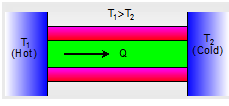Heat may be transferred from one body to the other by any of three possible ways: conduction, radiation and convection. In the conduction, convection phenomena, a medium is necessary for the heat transfer. Radiation, however, does not have this limitation. This is also the fastest type of heat transfer, in which heat is transferred from one object to the other in the form of electromagnetic radiation.
|
Conduction: Figure denotes a rod whose ends are in thermal contact with a hot reservoir at temperature T1 and a cold reservoir at temperature T2. The ends of the rod are covered with insulating medium, so the transport of heat is along the slit, not through the sides. The particles at the hot reservoir have greater vibration energy. This energy is transferred by attack to the atoms at
|

|
the end face of the slit. These atoms in convert transfer of heat through an object in which heat is transported without direct mass transport is known as conduction.
Most metals need another, more effective mechanism to conduct energy. The free electrons, which go throughout the metal, can rapidly take energy from the hotter to cooler parts, so metals are usually good conductors of heat. The presence of 'free' electrons also problems most metals to be good electrical conductors. A metal rod at 5°C seems colder than a piece of wood at 5°C because energy may flow more easily from your hand into the metal.
Heat transfer happens only between parts that are at different temperature, and the rate of heat flow is dQ/dt. This rate is also named the heat current, shown by H. Experiments give that the heat current is proportional to the cross-section area A of the rod and to the temperature gradient dT/dx, which is the rate of modification of temperature with distance along the bar.
H = dQ/dt=-kAdT/dx ... (1)
The negative sign is used to create dQ/dt a positive quantity since dT/dx is negative. The constant k, known as the thermal conductivity is calculated of the ability of a material to conduct heat.
Email based Physics assignment help - homework help at Expertsmind
Are you searching physics expert for help with Transmission of heat questions? Transmission of heat topic is not easier to learn without external help? We at www.expertsmind.com offer finest service of Physics assignment help and physics homework help. Live tutors are available for 24x7 hours helping students in their Transmission of heat related problems. We provide step by step Transmission of heat question's answers with 100% plagiarism free content. We prepare quality content and notes for Transmission of heat topic under physics theory and study material. These are avail for subscribed users and they can get advantages anytime.
Why Expertsmind for assignment help
- Higher degree holder and experienced experts network
- Punctuality and responsibility of work
- Quality solution with 100% plagiarism free answers
- Time on Delivery
- Privacy of information and details
- Excellence in solving physics queries in excels and word format.
- Best tutoring assistance 24x7 hours